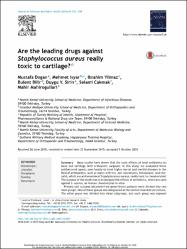Are the leading drugs against Staphylococcus aureus really toxic to cartilage?

Göster/
Erişim
info:eu-repo/semantics/openAccessTarih
2016Yazar
Doğan, Mustafaİşyar, Mehmet
Yılmaz, İbrahim
Bilir, Bülent
Şirin, Duygu Y.
Çakmak, Selami
Mahiroğulları, Mahir
Üst veri
Tüm öğe kaydını gösterKünye
Doğan, M., İşyar, M., Yılmaz, İ., Bilir, B., Şirin, D. Y., Çakmak, S. ... Mahiroğulları, M. (2016). Are the leading drugs against Staphylococcus aureus really toxic to cartilage? Middle East Respiratory Syndrome Coronavirus (MERS-CoV) Research Initiative Workshop içinde (251-258. ss.). Riyadh, Saudi Arabia, September 09-10, 2015. https://dx.doi.org/10.1016/j.jiph.2015.10.004Özet
Many studies have shown that the toxic effects of local antibiotics on bone and cartilage limit orthopedic surgeons. In this study, we evaluated three antibacterial agents used locally to treat highly mortal and morbid diseases in the field of orthopedics, such as septic arthritis. Are vancomycin, teicoplanin, and linezolid, which are archenemies of Staphylococcus aureus, really toxic to chondrocytes? The purpose of the study was to investigate the effects of antibiotics, which are used against S. aureus, on human chondrocytes in vitro. Primary cell cultures obtained from gonarthrosis patients were divided into two main groups. One of these groups was designated as the control chondrocyte culture. The other group was divided into three subgroups, and each group was exposedto vancomycin, teicoplanin, or linezolid. Cell culture samples were characterized by immunophenotyping following incubation with the three different antibiotics. Before and after the agents were administered, the cultures were subjected to inverted and environmental scanning electron microscopy. The number of live cells and the proliferation rate were monitored with the MTT-assay. We found that vancomycin, teicoplanin, and linezolid do not have chondrotoxic effects. Vancomycin, teicoplanin, and linezolid had no chondrotoxic activity during in vitro culture, which supports the argument that these agents can safely be used in orthopedic surgery, especially against methicillin-resistant S. aureus agents.

















